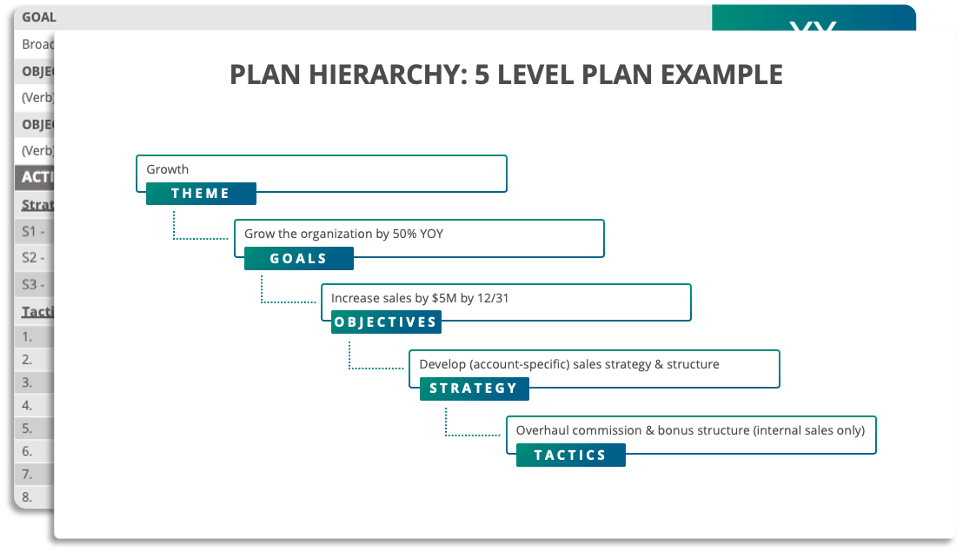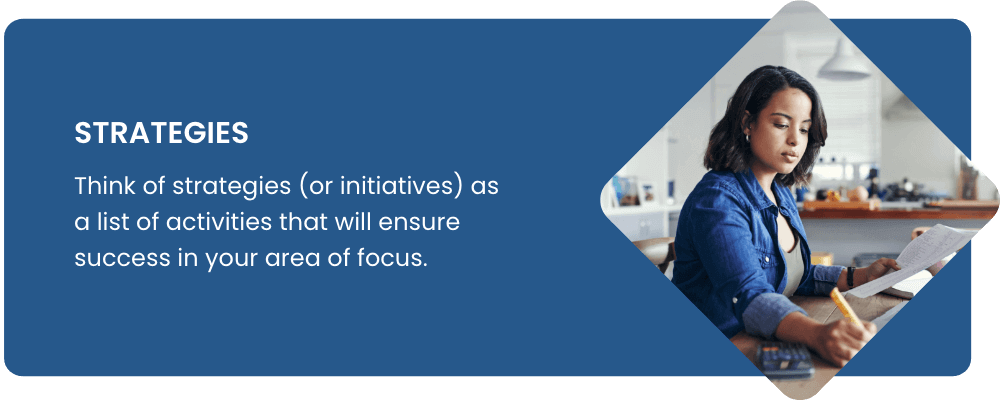Strategic planning can get complicated in a hurry. Has either of the following ever happened to you?
-
- Your boss attended a conference where the latest and greatest planning methodology was rolled out, and he expects you to be fully on board.
-
- Your organization has never had a strategic plan before and needs an idea of how to get started.
Either way, it’s important to keep things as simple and organized as possible. Let’s not make it harder than it has to be! One way to simplify the planning process is by starting with a strategic plan template. This plan helps you be more organized so that you can better strategize for your long- and short-term goals.
What Is a 5-Level Strategic Plan?
Almost every organization we work with struggles with goals that push at the limits of the time and resources they have available. Because of that, it’s important to be able to prioritize, categorize, and create areas of focus for your business. As you’ll see in our strategic plan template, we recommend a 5-level plan, as it forces you to narrow down and decide which areas of the business you’re going to commit to this year.
A 5-level strategic plan includes five steps that help your organization establish and strategize how you can accomplish your initiatives. Continue reading to learn the steps to make a 5-level strategic plan.
FREE RESOURCE
Strategic Plan Template
This five level strategic plan template will help you create a plan that’s built around best practices for optimized execution.

1. Themes
This is the first level of your strategic plan template, and it’s your chance to spell out what your organization plans to focus its attention on this year. Themes, often called areas of focus, are like the table of contents in a textbook. When you need to quickly access information, you scan the table of contents, zero in, and quickly jump to the area of interest.
We recommend applying this concept to your planning efforts because you’ll make your end product infinitely easier to navigate. Depending on your organization, you may have themes or may choose to split up the goals by departmental structure. Some examples of themes include:
-
- Healthcare: A healthcare system might have themes such as safety, quality, finance, and performance excellence.
-
- Business: An enterprise business may be more comfortable splitting its goals into departmental boundaries, such as sales, marketing, finance, customer success, and human resources.
-
- Federal agencies: An agency in the federal government might set themes such as accountability, project management, budgeting, and communication.
We recommend defining five to seven themes in your template.
2. Goals
The next level in your template is a goal. Each theme should be supported by a goal. Some organizations will refer to this level as objectives or key performance indicators (KPIs). This level contains the measures you’re going to track to get a good sense of how the business is performing.
Think of your department — or theme — and try to distill one to three indicators of health. A big mistake organizations make is attempting to track too many things. In choosing metrics, less is more. Select the metrics that are most meaningful, and track those numbers, percentages, or dollar amounts to hold people accountable and keep the organization focused on what truly matters.
Using examples from the previous section, a healthcare system’s theme of performance excellence might include goals that surround patient outcomes, such as tracking the number of readmissions per department. Comparitively, an enterprise business, a marketing goal may include tracking impressions on specific product pages.
In the strategic plan template, each goal is assigned a “card.” A card outlines the strategies and tactics, as well as the associated responsible parties and due dates, that relate to that particular goal.

3. Objectives
The next step in your strategic plan template includes setting objectives. Objectives and goals are similar, and though they’re often used synonymously, they differ on two points — length of time and specificity. A goal is broader and usually encompasses a longer period of time than an objective, which is more often short-term and specific.
Objectives break larger strategies and goals into more measurable actions. For example, a goal for a soccer team might be to score a penalty kick goal in their upcoming match. The objective for that goal might include something like practicing a specific kick a certain number of times in every practice before the big game.
Objectives are essential for any organization setting a strategic plan template, as they provide a scaffolding approach to achieving larger goals. They guide leaders and employees on specific actions they can take, essentially creating a list of directives.
To create strategic objectives, follow the following steps:
-
- Define where you are: Consider what your organization does well and where you experience pain points that need improvement.
-
- Establish where you want to be: Ask yourself what you want your organization to look like in the future.
-
- Consider the steps necessary to reach your goals: Create a list of potential actions you’ll need to take to get where you want to be.
-
- Set your objectives: When you set objectives, they should be relatively short statements that are specific, measurable, achievable, and time-bound (SMART).

4. Strategies
The fourth level of the template outlines the high-level items you’re going to work on to ensure all of your measures move in the right direction. Think of strategies or initiatives as a list of activities that will ensure success in your area of focus.
If one of your objectives includes a lofty sales target, one of your strategies might be to enter into a new market segment. If your objective is to reduce the days in accounts receivable, your strategy might be to offer an incentive or reward to your clients for paying early. On the other hand, if an objective includes decreasing injuries at work, a strategy might include instituting more training, so workers are more prepared for those situations.

5. Tactics
Now that you’ve defined the themes, goals, objectives, and strategies, you’re ready to divide up the work. Some of your initiatives can span several years, so it’s important to meaningfully report on progress over time. Project managers define this step as creating your work breakdown structure. Organizations typically struggle with this step because they try and define too much detail around each of their initiatives.
Think of your tactics as milestones, as the highlight reel for your strategies. They’re the most specific actions you can take to accomplish your strategies. For example, for the previous strategy to decrease time in accounts receivable, you might introduce tactics like creating copy to message clients with payment reminders.
Lastly, tactics are where you can start assigning due dates and responsible parties. Make sure that each tactic has one person responsible for providing status updates. This ensures that there is an owner who is held accountable for the tactic.

Using the Strategic Plan Template
This simple strategic plan template can help you create the outline for your organization’s plan. You can use this template to build a plan that’s clear, focused, and, most importantly, executable. We may be a bit biased, but we think it’s the best strategic plan template out there.
Start From the Top
The beginning of the strategic plan template provides an example of a strategic plan. This should be used as an outline for your plan. You’ll notice that the plan begins with a visual slide of themes around a target. This is something you might see in a presentation or plan outline.
Next is a Tree View of the plan, which shows how the themes and goals align. Finally, you’ll see a “card” — an individual goal outlined with metrics, strategies, tactics, accountable parties, and due dates. Each goal will have its own card.
To get started, begin by developing all of your themes. Again, think of the broad areas in which your organization needs to take action. Then, align goals underneath each theme. If a goal doesn’t align neatly with a theme, consider if this is truly a priority for the current year. After establishing your goals, set the objectives you need to take to reach those goals and follow that with the subsequent strategies and tactics you’ll take.
Make sure each tactic has one accountable party and a due date. These are both execution best practices. If a team is assigned to a tactic, no one acts as an owner of that item and it can become difficult to establish an approach. Setting time constraints on your initiatives also ensures you stay on the right track — consider establishing smaller due dates for your strategies and tactics as they build toward your objectives and goals. If all of your due dates are at the end of the year, people are likely to procrastinate.
Finally, do a spot check to ensure you’re not overburdening certain members of your team. And that’s it! You now have an easily readable and visual outline of your strategic plan.

About AchieveIt
AchieveIt is the platform large organizations use to get their biggest, most important initiatives out of the boardroom and into reality. Too many great ideas never quite make it across the finish line because there’s no real way to keep everyone on course and keep everything on track.
What does it take to actually guide these initiatives all the way through to completion? You’ve got to:
-
- Get everything in view: See what’s happening with every initiative, at every level, from the enterprise to the individual, in real time.
-
- Get everyone engaged: With an easy-to-use platform that connects your organization from the executive leadership to the project teams, keeping everyone accountable and on the same page is easy.
-
- Get every possible advantage: Because you’ll have the premier platform in this space, you can draw on the experience and best practices of our execution experts.
That’s why everyone from global corporations to regional healthcare systems to federal agencies has turned to AchieveIt for their Integrated Plan Management. Our platform makes it easy to connect, manage, and execute key plans and initiatives. Let’s actually do this.
Ready to improve your plan execution?
Organizations of all types leverage AchieveIt to manage, execute, and connect their most important initiatives. Replace manual processes & siloed systems with interconnected plans in a single, automated platform.



